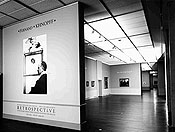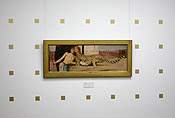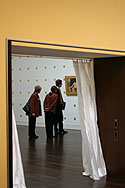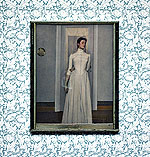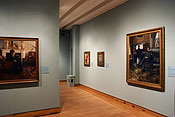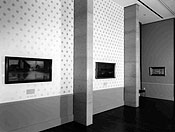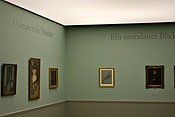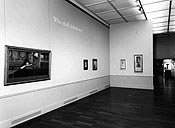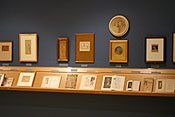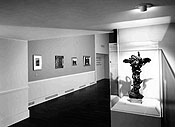The browser will either open the file, download it, or display a dialog.
|
Fernand Khnopff (1858-1921) organized by the Musées Royaux des Beaux-Arts de Belgique, Brussels, under the patronage of Their Majesties the King and Queen of the Belgians, 16 January-9 May 2004 The fully illustrated Fernand Khnopff (1858-1921) catalogue is available in cloth and paperback editions in French, Flemish, German, and English. 49.80 Euros |
|||||||||||
|
"In the end, he [Fernand Khnopff] had to arrive at the symbol, the supreme union of perception and feeling." Emile Verhaeren1 |
||||||||||
| In the past decade, the Royal Museums of Fine Arts in Brussels has been the organizing institution of a small group of important exhibitions of works by some of the foremost figures of Belgian modernism, including James Ensor, Réné Magritte, and Paul Delvaux. These exhibitions were held as anniversary celebrations of the artists' births or deaths, as is often the case for a retrospective. During the spring of 2004, visitors to the Royal Museums of Fine Arts of Belgium were treated to Fernand Khnopff (1858-1921), the most recent of these major exhibitions. (fig. 1) For this retrospective, the curators did not wait for an anniversary to present the artist to the public. Instead, as Frederik Leen points out in his introduction to the catalogue, the curatorial staff decided to organize the show, initially begun as a collaborative effort with the Museum of Fine Arts in Montreal, "because we felt like doing it and because we wanted to realize it now" (p. 9).2 The eponymous retrospective contained almost three hundred objects, of which more than 265 were by Khnopff. The remainder was comparative works by fellow Belgian and foreign artists with whom Khnopff's work formed a dialogue in the international symbolist movement. Smaller, and, as a result very different, versions of the exhibition traveled to Museum der Moderne, Rupertinum in Salzburg, Austria during the summer, and to The McMullen Museum of Art at Boston College in the fall. These latter exhibitions contained many of the important highlights of the much more complete Belgian venue. | |||||||||||
| The sheer scope and depth of the Royal Museum's Khnopff exhibition allowed visitors an extraordinary once-in-a-lifetime opportunity to examine the utter richness of the artist's voluminous output. Khnopff experimented in a variety of media. Best known for his paintings and for his pastel works, Khnopff was also a masterful sculptor, photographer, frame designer, illustrator of literary texts, costume designer, and interior designer.3 The show included both famous and completely unknown works and installed multiple versions of some subjects to document the different evocations the artist achieved through palette modifications. This was particularly instructive in the case of Avec Grégoire Le Roy. Mon coeur pleure d'autrefois (cats. 155-159). Five of the seven versions of the subject were exhibited in Brussels, the most that have been shown together until now.4 | |||||||||||
| Khnopff has long been considered the leading Belgian artist associated with symbolism. As the exhibition in Brussels made clear, despite Khnopff's training in Brussels at the Academy, his imagery makes solid use of illusionism while, at the same time, it invariably includes details that undercut any simple notion of a reality effect. Likenesses are maintained not as ends in themselves, but as the means of suggesting a combination of thought, emotion, an internal state of mind, mystery, and emblematic symbols that do not come wholly from the outside world, but instead from an internal impulsion. As a result, they evoke a desire to penetrate the work in new, often emotionally charged ways. Khnopff did this in a variety of ways. In some instances, he produced works that invigorate the image's surface as a kind of veil, while in others, he included a profusion of mysterious details—crystals, dimensional anomalies, uncanny points of view, fragmented bodies and scenes, anti-naturalistic tonalities, and claustrophobic compositions—to deepen the emotional response to a given work. | |||||||||||
| Khnopff was an immensely famous and sought-after artist during his lifetime for both his society portraits and esoteric subjects. Most of his work remains in private hands, although the Royal Museums in Brussels own many of his most celebrated paintings. As a leading exponent of symbolism in Belgium, the newest art form in Europe during the 1880s and 1890s, he was an important founding member of the Brussels-based independent exhibiting groups, Les XX (1883-1892), and its successor La Libre esthétique (1893-1914). Beginning in 1895, he was also the Belgian correspondent for the British modern art journal, The Studio. As the photograph in the entrance to the exhibition made clear, Khnopff saw himself as an aestheticized figure who, even if he was a member of the Belgian Workers Party's Art Section, projected himself as above the fray of the quotidian.5 While he outlived the Symbolist era and by the end of his career had already fallen out of favor among the art-buying public, his art remained remarkably consistent as a painter of "sentiments."6 | |||||||||||
| In the last two decades, Khnopff has been the subject of numerous large-scale shows.7 Nonetheless, his art remains far less renowned in the public imagination than are the works of his better-known Austrian, British, and French counterparts, especially Gustav Klimt, Edward Burne-Jones, and Gustave Moreau, with whom his oeuvre contains important affinities. For this reason, it was particularly fortuitous that The McMullen Museum at Boston College was able to bring a smaller version of the exhibition to the United States during the autumn months. The exhibition in Brussels paired Khnopff with works by these and other artists; in so doing, their works served both as a way to contextualize Khnopff's enigmatic imagery within the international symbolist era, and to document, in particular, his innovations in the creation of portraits.8 | |||||||||||
| Who Khnopff was, and the hermetic way he saw the world, became abundantly clear in the organization of the exhibition in Brussels. In broad terms, the show presents the locales Khnopff inhabited and the subjects that meant most to him. The eldest of three children, Fernand Khnopff was born in 1858 into an upper middle class family at the chateau at Grimbergen-lez-Termonde near Brussels, the home of his maternal grandparents. In the following year, the family moved to Bruges where they lived until 1866. The artist's two younger siblings—the future poet and critic Georges, (b. 1860) and Marguerite, the artist's favorite model until the early 1890s, (b. 1864)—were both born in Bruges. Although Khnopff is said to have returned only returned once, the representation of Bruges would become a central theme for him, especially after 1900.9 Two large galleries in Brussels were devoted to Khnopff's Bruges imagery. The family returned to Brussels in 1866, and summered in the Ardennes in the village of Fosset, where they owned a sizeable property. Similarly, Khnopff's landscape and figural paintings made at Fosset formed a leitmotif throughout the exhibition. | |||||||||||
|
The show was organized both visually and thematically around a series of reflections or oppositions, between landscape and figural works, between society and hermeticism, between the unique object and its reworked reproduction, and between early and later works that are related visually, thematically or technically. These reflets were echoed, as well, in the ways that the show's designers chose to paint the walls. Each gallery's wall contained tonal complements both within the room, and in contrast to the galleries adjacent to it. In a nod to both the bourgeois environments in which many of Khnopff's paintings were installed, and to Khnopff's own essays on design for The Studio, several of the galleries were decorated with floral wallpapers that evoked William Morris' and other British Arts and Crafts designs. Some of these details were harmonious and highlighted important examples within a particular theme, while others were distracting. |
|||||||||||
| The most jarring of the installation techniques used in the Brussels version of the exhibition took place in the final gallery. Art or The Caresses, (1896) was hung by itself on bright white walls onto which golden squares were painted. (figs. 2 and 3) This gallery evoked the esthetically spare character of Khnopff's 1900 "temple of art," his unique Viennese Jugendstil-inspired home on the Avenue des cours, especially with the curtained door at one end of the gallery (leading to the ubiquitous gift shop for the exhibition). It nonetheless marked a radical departure from the way that the curators had hung the rest of the exhibition.10 | |||||||||||
| Divided into a series of often overlapping themes that echo Khnopff's synesthetic, evocative, transcendental, and mysterious themes, this exhibition documents the artist's explorations in a variety of media and subjects.11 The first gallery, titled "On n'a que soi" ("One only has oneself"), contained the artist's early family portraits, including the 1887 Portrait of Marguerite Khnopff (Brussels, King Baudouin Foundation on permanent loan to the MRBAB) set against a Morris-inspired floral wallpaper of turquoise and white. (fig. 4) In addition, there was a small group of the artist's early images of Fosset, and the always instructive pairing of Khnopff's Listening to Music by Schumann (1883) with James Ensor's impressionist Russian Music (1881) (fig. 5). When these paintings were first shown together at the 1886 Les XX exhibition, Ensor accused Khnopff of plagiarizing his earlier painting, thereby cementing their lifelong animus.12 Their juxtaposition in the museum space nonetheless demonstrated, even without the use of didactic panels, just how different their approach to the subject of playing and listening to music was. Ensor presents a genre scene of a man, open eyed in the act of listening to music being played for him by a woman in an overstuffed bourgeois interior. In contrast, Khnopff's early masterpiece reveals the abstract quality and tension associated with the act of listening to music, and the opportunity it provides for the depiction of emotional transport. Khnopff's mother sits in a similarly claustrophobic interior with her head cradled in one hand, seemingly unaware of her surroundings, while her other hand is clenched in her lap. Her positioning evokes a turning in on herself rather than a genre scene. This pairing opened the installation in Boston, and demonstrated Khnopff's departure from Impressionism even in his early works. | |||||||||||
| The objects in the second gallery, titled "En écoutant des fleurs" ("listening to the flowers"), comprised a combination of early symbolist and late symbolist imagery inspired by poets and poetry. Among the works in this gallery were the two versions of Khnopff's La Poésie de Stéphane Mallarmé (en écoutant des fleurs) of 1892 and 1895, respectively. The early version of this graphite and pastel image was published in the German periodical, Pan, in 1895 as an illustration Mallarmé's "A la nue accablante tu" (cats. 26 and 27). Other works in this gallery included the extraordinary, late Orpheus, (1913), a graphite, colored pencil and pastel now in the collection of the Communauté française de Belgique, on temporary loan to the Modern Art Museum in Liège, (cat. 24) and the justifiably famous Du Silence, ("On Silence") (1890) from the Royal Museums collection. (cat. 21) While it was useful to study the development of Khnopff's pastel techniques over time, it was nonetheless confusing to view both early and late works together. Such pairings continued throughout the exhibition. | |||||||||||
| A small group of Khnopff's paintings from the village of Fosset, and many of his most important pastels of Bruges, were situated in the third gallery, "Between Two Worlds" while the remaining images of Bruges and Fosset were located at the opposite end of the exhibition in several additional galleries. (fig. 6) Evoking the earth and water tones found in the paintings in this gallery, the walls were painted in a gray blue and a flesh tone. It was here that Khnopff's mastery and abstraction of the landscape was first established. Even if Khnopff is not associated with the plein-air painting of Impressionism, his Fosset scenes, almost invariably devoid of humans, were painted on small wooden panels, suggesting that he used these easily portable panels to work outdoors. Of particular note in this gallery was the 1894 The Motionless Water now in Vienna's Belvedere Gallery (cat. 44) as well as several Bruges-inspired pastels from the Hearn Family Trust. For comparison's sake, landscapes by Piet Mondrian, Willem de Gouve de Nuncques, and Anna De Weerdt were also installed, demonstrating that Khnopff's close cropping of trees, buildings, and the landscape more generally was part of a larger idea of abstracting the landscape. | |||||||||||
|
Khnopff's early, monumental pastel, Memories (Lawn Tennis) of 1889, as well as its preparatory sketches, was installed alongside additional images of Marguerite and portraits of children. Unfortunately, however, the photographs taken by the artist of his sister as preliminary studies for Memories were located in a subsequent gallery so that obvious comparisons were impossible. Memories was exhibited at the 1889 Universal Exposition in Paris, where it was awarded a second-class medal. Its size, and the isolated quality of the repeated likenesses of Marguerite Khnopff in a landscape suggest that Ensor's Christ Entering the City of Brussels (1888, Getty Art Museum) was not the only Belgian response to Seurat's 1885-86 masterpiece Sunday Afternoon on the Island of La Grande Jatte, (Art Institute of Chicago), after the French masterpiece was shown at the 1887 Les XX exhibition. |
|||||||||||
|
That Khnopff was a masterful and modernist portraitist was evident especially in the Portrait of Jeanne de Bauer, (1890) from the Stepanski Family Collection. In an evocation of his deep appreciation of early Netherlandish portraits of the fourteenth and fifteenth century, Khnopff placed the young woman in strict profile in front of a delicately decorated cloth of blue and gold.13 Another aspect of Khnopff's successful career as a portraitist is abundantly clear in the Posthumous Portrait of Marguerite Landuyt, (1896) which the Royal Museums purchased from the Landuyt family in 2002. In this portrait, a brilliant counterpoint to his 1887 portrait of his sister, Khnopff's incipient symbolism is now fully articulated. Using a photograph furnished by her parents, the recently deceased young woman is dressed in virginal white, similar to that in Khnopff's portrait of his sister, and seems to float in a delicately rendered interior. The flowers decorating the wall behind her are marguerites, while she holds a red cyclamen in her hand. These flowers form allusions to her name, to innocence, and to her far too early departure from life. |
|||||||||||
|
Two galleries devoted to "A Glimpse of the Mundane" focused on the society portraits Khnopff made throughout his career and the numerous red chalk drawings he produced of women's faces. Here we see Khnopff's innovative compositional device of cutting off the head just above the eyebrows as a way to enhance the dreamlike quality of the sitter's gaze, while also evoking her likeness. (fig. 7) | ||||||||||
| The exhibition returned to the more evocatively symbolist works in a series of galleries entitled "Nevermore," "Who Shall Deliver Me?" and "Solitude." (fig. 8) The first of these rooms alluded to Edgar Allen Poe's famous poem, "The Raven," as the literary referent for Khnopff's three tondos of The Dreamer. In addition, two versions of his sculptures of A Young Englishwoman (1898, cat. 103) and Mask of a Young Englishwoman (1891, cat. 104) further demonstrated his anglophile interests. These works paved the way for the second of these galleries, which referred to the poetry of Christina Rossetti, whose works inspired two of Khnopff's crucially important symbolist paintings, Who Shall Deliver Me? (Christina Georgina Rossetti), (1891, cat. 122) and I Lock My Door Upon Myself, (1891, cat. 120). These works were paired with Jean Delville's Mysteriosa, (1892, cat. 121) his occult-inspired portrait of Mrs. Stuart Merrill, the wife of the British poet. | |||||||||||
|
The depiction of the isolated, claustrophobically rendered, female figure reached its apogee in the Isolation triptych of c. 1890-94 in the gallery devoted to "Solitude." Brought together for the first time since 1990, this monumental triptych echoes the formats of early Netherlandish altarpieces in its use of grisaille for the two wings of Acrasia, (1894) and Britomart, (1894), characters from Spenser's The Faerie Queen. Together, these two wings present the binaries of woman; the former is seductively posed nude with her hand over her head, while the latter, a virginal warrior, is cloaked in full armor. The central panel of Solitude, (c. 1890-91) by contrast, presents a woman dressed in black holding a sword, and surrounded by crystalline orbs in which spectral angels and references to the crucifixion emerge. |
|||||||||||
|
Khnopff was also a much sought-after illustrator of literary texts. His illustrations and occasional prints were situated in a large gallery, while a group of his independent prints and retouched photographs were located elsewhere. Set up as a nineteenth-century library, the lithographs and drawings in this room included preparatory and finished illustrations, along with many of Khnopff's ex-libris projects, his catalogue covers for Les XX, and a group of costume designs he produced for the Théâtre Royal de la Monnaie in Brussels between 1903 and 1914. (fig. 9) The two vast spaces devoted to Khnopff's prints and retouched photographs provided ample opportunity for visitors to make comparisons between media and subjects. | ||||||||||
|
Two additional galleries presented Khnopff's sustained interest in Fosset and Bruges. In the first was In Fosset. The Entrance to the Village, (1897), an astonishing blue-toned image of the hamlet that so entranced the artist. Khnopff's use of the icy blue hues in this painting give the scene, which otherwise would be an entirely naturalistic rendering, a silent and frigid sense. The remainder of Khnopff's nostalgic images of Bruges, and other medievalizing subjects, located in the second gallery, were collaborations with the Symbolist authors, Grégoire Le Roy, and Georges Rodenbach. In addition to the previously mentioned multiple versions of With Grégoire Le Roy, My Heart Weeps for Days of Yore, (1889), were Secret-Reflection, (1902, Bruges, Groeningemuseum), three studies for The Mirror of Venus, (c. 1873) by Edward Burne-Jones, and Khnopff's 1904 Abandoned City depicting the Memling Square, absent its nominal statue and filling with water. This gallery also presented Avec Georges Rodenbach. Une ville morte, (1889) and the 1907 monumental drawing, Requiem, which appears to mark the artist's unique detour into an Italian setting. This drawing documents that Khnopff never completely forgot the lessons of his academic training. Set in the richly decorated interior of Santa Maria in Trastevere, a looming archangel holds an orb and wears an elaborate figural vestment. To his right, hanging jewel-like from a chain, is a diminutive angel shimmering in a blue aura. This small area of blue marks one of two spots of color in an otherwise monochromatic image. |
|||||||||||
| The lushly illustrated catalogue is a welcome, if sometimes frustrating, addition to the extensive literature on Khnopff. Its organization conforms to that of the Brussels installation, and documents the many instances where related works were isolated from one another without explanation. Most of the major works are provided with extensive catalogue entries. One of the key oversights in the catalogue, however, is the absence of an entry on I Lock My Door Upon Myself, (1891, cat. 120) especially since it could be related both to the formal abstractions of the Fosset imagery, and because of the way that the picture plane is enlivened, and symbolically undercut, through the inclusion of the daylilies and hanging tiara. A number of these entries are tantalizing, especially those by Gisèle Ollinger-Zinque, eminent Khnopff scholar and emerita Royal Museum curator of nineteenth-century painting, on A Bewitching (c. 1912, cat. 127) and Khnopff's most famous painting, Caresses (1896). These brief texts provide readers with new documentary evidence that enhance our knowledge of the artist's oeuvre. Frederik Leen's entry on Memories, likewise, is a tour-de-force analysis of Khnopff's "uncoupling of symbol and content" (p. 120) and underscores his understanding of twentieth-century minimalist art and theory. Dominique Marechal's catalogue entry on Secret-Reflection, (1902, cat. 165) similarly is an ideal short essay; it is a model in making the allusive character of Khnopff's imagery intelligible. Given the extraordinary interpretive and factual depth of these catalogue entries, it would have been heartily welcome if the organizing committee had decided to include catalogue entries on each of the works displayed. Doing so might also have clarified how different works related, both across galleries and across the thematic divides. | |||||||||||
| While the catalogue forms a fine thematic monograph on the artist, several of the texts seem to have been written with the specialist and theoretically-savvy in mind. In his essay "Fernand Khnopff and Symbolism," Frederik Leen provides a synthetic analysis of European Symbolism from a deconstructive framework, addressing an academic rather than a general audience. In this sense, Leen's essay works stands out from the more straightforwardly written essays by the other authors. He correctly presents Khnopff as an artist whose work is devoted to ambiguities and indeterminacy and he nicely situates the artist within the larger international symbolist project. This essay, nonetheless, is perhaps best read in concert with previous scholarship since Leen does not delve deeply into Khnopff's thematics.14 | |||||||||||
| Jeffery Howe's essay on "Between Angels and Animality: Religious Themes in the Art of Fernand Khnopff" discussed a little-studied, yet crucial aspect of the artist's oeuvre. Taking as his starting point the problematic of religion in the nineteenth century, Howe weaves together Khnopff's productive involvement with the binaries of flesh and spirit, occult symbolism, the Salons de la Rose+Croix, and his later return to more traditional religious imagery. Complementing such abstract essays, Dominique Marechal's "Eternity Reflected Motionless in the Water, Fernand Khnopff: From Bruges to Fosset," provided ample biographical and iconographic analysis to situate Khnopff's imagery. He then presents an intriguing argument that Khnopff's Bruges imagery forms a psychological self-portrait. The village of Fosset is also given prominence, especially since the artist painted some forty landscapes of this locale between 1880 and 1897. Khnopff's Fosset imagery is not typical, Marechal argues, of plein-airism, or even of quickly rendered scenes. Instead, such images are "solid, well-thought-out and subtly felt compositions that do not imitate but interpret nature." Like Khnopff's Bruges imagery, the subject of the Fosset paintings is memory, the "interior image that remains of direct experience—of an ideal nature that no longer exists" (p. 42). | |||||||||||
| Laurent Busine's essay, "To Sir Edward Burne-Jones from Fernand Khnopff," focuses on the important relationship between the Belgian and British artists as well as Khnopff's anglophilia. Busine traces the many visits Khnopff made to England, his use of British literature as the basis for some of his works, his involvement with the Studio from 1894 and 1914, and the exchange of drawings between the two artists in 1896. | |||||||||||
|
The theme of the Medusa and the myriad ways that Khnopff represented this mythological figure is the subject of Michael Sagroske's text, "An Art of the Sign: The Medusa in the Work of Fernand Khnopff." (fig. 10) He examines the traditions of Medusa imagery from Caravaggio forward as a way to suggest the unusual nature of Khnopff's iconography. In only one instance did Khnopff render the gorgon with her hair formed by snakes. In all of the other images of the Medusa, Khnopff's mythological figure conforms in name but "lacks every association with the traditional type of the Medusa as well as the type of the femme fatale." Khnopff's Medusa imagery subordinates tradition; instead, such works "remain independent in their meaning and completely subordinated to the private iconography of the artist" (p. 63). | ||||||||||
| Khnopff's involvement with the "Théâtre Royal de la Monnaie" between 1903 and 1914 is the topic of Joris Van Grieken's essay. Having attended the opera since childhood, and given his profound interest in literature, it is hardly surprising that Khnopff would want to ally himself with the opera and theatre. His long collaboration with the opera house in Brussels gave him the opportunity to work on a diverse group of productions, including Ernest Chausson's opera Le Roi Arthus in 1903, Debussy's Pelléas et Mélisande in 1907, and Wagner's Parsifal (1914). | |||||||||||
| Two short essays by Anne Adriaens-Panier examined Khnopff's work in photography and printmaking, and Khnopff's career in illustration is the subject of Sophie Van Vliet's essay. Khnopff's involvement with photography, as pointed out in the essay, was not straightforward, even if he began exploring in this medium in 1888 while working on Memories. In 1916, Khnopff gave a talk in which he said: "We are neither for nor against photography. The photographer can help to document the artist; the artist can refine the taste of the photographer" (p. 249).15 As Adriaens-Panier points out, however, Khnopff used the medium of photography more than any other artist of his generation. She then traces the two-pronged approach Khnopff used. On the one hand, he created photographs that he would copy and, in some senses, perfect, for many of his images. And, he worked in collaboration with Alexandre, a well-known Brussels-based photographer. In these latter pieces, however, Khnopff often would retouch the images with graphite and pastel to such an extent that they no longer "read" as photographs. In her essay on Khnopff's prints, Adriaens-Panier details Khnopff's involvement with the Société des Aquafortistes belges (the Society of Belgian etchers) from 1886. Van Vliet discusses the rich diversity of illustration and occasional print projects Khnopff developed beginning in the 1880s. His last illustration was completed in 1920, a year before he died. Despite the relative paucity of illustrations for these last two essays, it is clear that Khnopff's work with writers, and organizations as diverse as Max Waller, Emile Verhaeren, Grégoire Le Roy, Henry Carton de Wiart, Joséphin Péladan, the publisher Edmond Deman, and the Section d'Art of the Maison du Peuple in Brussels, speaks to his central role in the history of book illustrations at the turn of the century. | |||||||||||
| Despite my small criticisms, the Fernand Khnopff exhibition organized by the Royal Museums, and its accompanying catalogue, both achieved a monumental task. They pulled together a large number of works that documented Khnopff's extraordinary and sustained oeuvre in a large variety of media, while also placing him into the context of European symbolism. In addition, the catalogue explored the complexity of the artist's imagery by including essays on many of his themes and technical experiments. In the process, the catalogue provides many new areas for future projects on this crucial and fascinating Belgian artist. | |||||||||||
|
Sura Levine |
|||||||||||
|
My warm thanks to Aaron Berman, dean of faculty, Hampshire College, for providing me with the funds to go to the exhibition in Brussels, Maurice Tzwern, Nancy Netzer, Susan Canning for reading a draft of this essay, and especially to Jeffery Howe for furnishing me with photographs and the wall texts from the McMullen's installation of this exhibition. An equally large debt of gratitude is here recorded to the staff and emeritus staff of the Musées Royaux des Beaux-Arts de Belgique, in particular Gisèle Ollinger-Zinque, Pierre Baudson and Francisca Vandepitte for their many types of assistance and expertise. 1 . Emile Verhaeren, "Silhouettes d'artistes. Fernand Khnopff," L'Art moderne VI, number 37, 12 September 1886, p. 289. 2. This and all subsequent quotations from the catalogue Fernand Khnopff (1858-1921), (Brussels: Musées Royaux des Beaux-Arts de Belgique, 2004) are from the English edition and will be cited by page number in the text. Although the Montreal Museum originally collaborated with the Belgian Royal Museums on this exhibition, the Canadian Museum eventually withdrew from the project because of the daunting costs associated with bringing such a large exhibition across the Atlantic. 3. A number of the works in this show are still housed in the frames designed by the artist. Of these, the Japanese inspired embossed copper frame surrounding In Fosset. An Evening (1886, cat. 14) now in the Hearn Family Trust and the gold, altarpiece-like frame for Standing Woman (c. 1898, cat. 29) from a private collection document the artist's innovations in framing devices. An instructive exhibition of Khnopff's designs for these and other frames should be organized. 4. When the show came to Boston, only the two versions owned by the Hearn Family Trust were included. 5. Two works in this exhibition allude to Khnopff's awareness and sometime involvement with contemporary and political subjects. These are the newly rediscovered small colored pencil and pastel image of The Shrimp Fisherman (1912) (now in the collection of the Hearn Family Trust) and the cover design Khnopff drew for Annuaire de la Section d'Art et d'Enseignement de la Maison du peuple in 1893. Until now, The Shrimp Fisherman was known only by its listing in the estate sale of Khnopff's works in 1922. 6. Maria Biermé, Les Artistes de la pensée et du sentiment, (Brussels: La Belgique Artistique et Littéraire, 1911). 7. These exhibitions include and Fernand Khnopff and the Belgian Avant-Garde, Chicago: The David and Alfred Smart Art Museum, University of Chicago, 1984; Fernand Khnopff (1858-1921) organized by the Musées Royaux des Beaux-Arts de Belgigue, which traveled to Musée des Arts Décoratifs in Paris and the Kunsthalle in Hamburg in 1979 and 1980; and a show supervised by the Ministry of Foreign Affairs in Japan that traveled to four venues in Japan in 1990 (Fernand Khnopff, 1858-1921). 8. Comparative works in the exhibition included a portrait of the artist's wife by Franz von Stuck, landscapes by William de Gouve de Nuncques, Anna de Weert, and Piet Mondrian, paintings and drawings by Dante Gabriel Rossetti, Edward Burne-Jones, Jean Delville, and etchings by Félicien Rops. 9. Khnopff argued that his memory of Bruges was sufficient inspiration to create his Bruges-based images. It nonetheless is evident that the artist used the relatively recent invention of postcards for the scenes he chose to render of Bruges in that his images tend to be among the more picturesque and best known sites in this medieval city. During his only known return to this city he is said to have worn a blindfold in order not to have his memories tainted by the reality of the city. For additional information on Khnopff's relationship to Bruges, see Dominique Marechal's essay in the catalogue for the present exhibition, which will be discussed below, as well as Lynne Pudles, "Fernand Khnopff, Georges Rodenbach, and Bruges, the Dead City," Art Bulletin LXXIV/4 (December 1992), 637-654. 10. Khnopff's house was designed in 1900 in collaboration with the architect Edward Pelseneer. Monumentally enlarged period photographs of the house were also included in one of the side galleries in Brussels and Boston. 11. Following its long-held tradition of not providing didactic panels and detailed wall labels, the show in Brussels only included titles, dates and owners on the labels. In the installation in Boston, by contrast, each section of the show and each work was accompanied by extensive analytical texts. 12. For more on the conflict between Khnopff and Ensor, see Henry Bounameaux, "Ensor-Khnopff: la querelle d'une image?" Bulletin Musées Royaux des Beaux-Arts de Belgique, Brussels 1-4 (1992-1993), 127-147. 13. During the 1890s, Khnopff gave at least one lecture on Netherlandish painting at the Section d'art at the Workers Party Headquarters, la Maison du peuple in Brussels. His portrait of Madame de Bauer (1893) and the preparatory sketch for the portrait were located several galleries away in the "Glimpse of the Mundane" section. In Boston, however, mother and daughter were shown side-by-side giving viewers an opportunity to compare their strictly profiled portraits. 14. Some of the most important recent texts on Khnopff include: Jeffery Howe, The Symbolist Art of Fernand Khnopff (Ann Arbor: UMI Research Press, 1982), Robert L. Delevoy, Catherine de Croës and Gisèle Ollinger-Zinque, Fernand Khnopff. Catalogue de l'oeuvre, 2nd edition, Brussels: Lebeer Hossman, 1987, and Michel Draguet, Khnopff ou l'ambigu poétique, Brussels: Crédit Communal, 1995. 15. Fernand Khnopff, "A propos de la Photographie dite d'Art," address given on 8 June 1916 to the Classe des Beaux-Arts de l'Académie Royale de Belgique, in Annexe aux Bulletins de la Classe des Beaux-Arts, Communications présentées à la Classe en 1915-1918 (1919), p. 95
|


